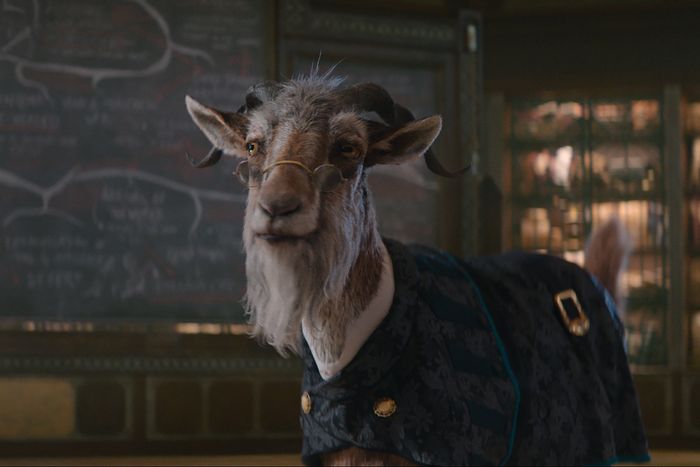
Wicked’s full-scale assault of a marketing campaign wants you to believe that the movie is simply a female-friendship story between a pink witch and a green witch, set at a girl-power Hogwarts, featuring “Defying Gravity” and some other, less famous songs, as well, all taking place before The Wizard of Oz. What the marketing has largely and maybe cleverly left out is that, as much as this is a musical movie and an Ariana Grande movie and a magic movie, it’s a talking-animal movie. Wicked is a profoundly weird show. The first act of the stage show — on which this entire first film is based, with Part Two coming next year — is driven by a plot about the shifting legal status and persecution of animal citizens of Oz, who are being removed from as many corners of public life as possible in a Third Reich–coded plot masterminded by [spoiler alert] the Wizard. The animals are scapegoats for populist unrest, and the tribulations of goat-professor Dr. Dillamond spur protagonist Elphaba to travel to the Emerald City and rebel against the Wizard. This Zootopia-inflected plot is why she sings “Defying Gravity” in the first place; rather than accept a position in the Wizard’s Cabinet that would give her power and acceptance at the expense of her morals, her terror at the animals’ plight is so great that she vows to expose the Wizard as a fraud, hops on a broom, and battle cries her way into the show’s intermission.
In the stage show, Dillamond & Co. are represented by human actors walking around bipedally with headpieces and prosthetics. They look like steampunk furries. The flying monkeys are their own category, their monkey-ness represented more through acrobatics and Serkis-ish body language than appearance. It’s all a bit ugly and a bit unremarkable, nothing like the elaborate puppets of something like The Lion King, so it’s easy to forget that any of this is an element of the show in the first place. Growing up, I saw Wicked onstage once but listened to the original-Broadway-cast recording hundreds of times, almost always skipping Track 5 — “Something Bad.” The animal nonsense takes up a fair amount of the show’s book, but “Something Bad” is the only song on the recording where any of it is really mentioned, and the song itself is an exposition dump that’s unpleasant to listen to on its own as music, so I was taken by surprise when I revisited the show as an adult and saw that Dr. Dillamond basically drove the A-plot. Early trailers for the film hid any mention of Dillamond altogether. How would this possibly translate to the screen?
The movie’s most radical act of adaptation, it turns out, is making Dr. Dillamond cute, thank Oz! Wicked: Part One is faithful to the musical’s first act, but it’s also an entire hour longer, so the run time is padded out with extra dialogue, jokes, and world-building. A huge amount of that world-building is just rendering a bunch of photorealistic CGI critters in clothing. They look like the creatures in one of those lackluster “live-action” Disney adaptations, only a bit less taxidermy/soulless around the eyes and a lot cuter because they’re wearing clothes, and because they’re not taking classic 2-D character designs and making them worse (they’re taking ugly steampunk furry character designs and making them better). There are plenty of goofy little flourishes throughout the film where the animals come in clutch: The students sneak out to a speakeasy where they dance to an animal band featuring a sugar glider on the drums. In the Emerald City sequence, two chickens in top hats waddle across a crowd scene. Fiyero (Jonathan Bailey) rides a talking horse. Within the first ten minutes of the movie, we flash back to Elphaba’s troubled delivery, where her being born green is seen as a huge issue, but it’s perfectly normal that the midwives are a bear-voiced by esteemed actress Sharon D. Clarke and a wolf in a little doctor’s getup. This is all pure fairy-tale shit, and Wicked only makes sense when it’s operating with open acknowledgment of its fairy-tale broadness. The talking animals signal that Wicked is, like The Wizard of Oz, a fable for children, and they remind us that we must judge it accordingly, rather than nitpick our way out of enjoying it.
(Okay, one brief nitpick: The fact that the animals’ plight is rendered overtly as a parallel to the slow creep of Nazism — with the normalization of anti-animal prejudice and animals who once held positions of power throughout higher education being barred from teaching — makes Glinda’s whole deal very strange. By the time the film reaches the climactic moment of “Defying Gravity,” Glinda’s urging Elphaba to just calm down, go along with and apologize to the wizard equates to her saying, “Elfie, listen to me, just be racist!”)
Where the CGI animals work best is by far Dr. Dillamond, voiced by Peter Dinklage. All they had to do was make Dr. Dillamond look like a real, cute goat dressed in little glasses and Banshees of Inisherin–worthy knitwear, and suddenly, for the first time in the over 20 years I’ve loved Wicked, I actually cared about the animal plotline at all. Onstage, where Dr. Dillamond is just a character actor in goatface, the “animals should be seen, not heard” plot is just a clunky metaphor. But onscreen, seeing Elphaba and Glinda’s history professor as an adorable little goat sparked the same reaction that I get at movies in which a dog is in peril; it heightens the stakes and makes Elphaba’s crusade really click. There’s a lot of visually interesting business with how Dr. Dillamond goes about his life as a goat in a people’s world: He kicks a special lever to start his classroom projector, and in his Hagrid’s Hut–style cozy cottage he has a tilting teapot and a mug with a little groove for a hoof. His friends are a snow leopard with a big white mustache and a thimble-size marmoset who also sports a big white mustache. It’s all extremely whimsical, but it also elevates the material. When he is subjected to a hate crime, or dragged away by the authorities, it’s extra sad because he is only a sweet little goat! No longer is this only an inelegant metaphor for witch hunts (ohhhhh, I just got it) and identity-based persecution; it’s Au Hasard Balthazar! It’s, against all odds, the single best improvement the film makes to the stage show.
And yet, zero cute Dr. Dillamond merch? An outrage!


